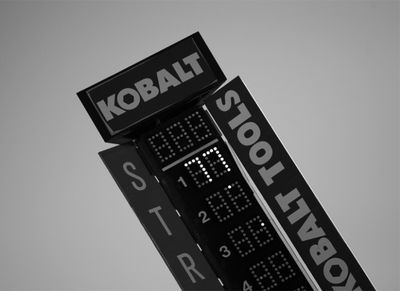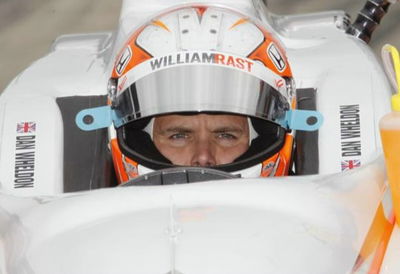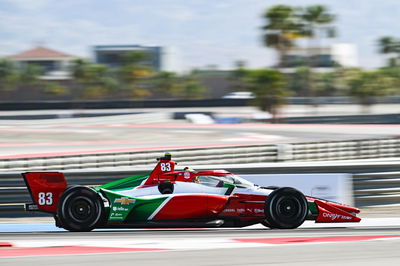Vegas: just what exactly happened?

All season long, IndyCar had been working toward this moment: the season finale, the IZOD IndyCar Series World Championship - a celebration of the sport and a confirmation that IndyCar was finally on its way back after some difficult years with internal divisions, feuding and a collapse in popularity.
Utilising all his PR industry skills, IndyCar CEO Randy Bernard had done everything he could to put together the perfect show to attract fans back for the weekend, appropriately set in the glitziest showbiz city in the world - Las Vegas. There was a week of media activity that included a parade of IndyCars down the Strip, and the unveiling of a new trophy for the champion; he had been helped by the championship battle itself coming down to a knife-edge climax between Dario Franchitti and Will Power. There was even the final appearance in an IndyCar of Danica Patrick to add to the mix and grab the headlines one last time, before her move to NASCAR Nationwide Series next year.
And then there was the small matter of the $5m prize being offered to the 2011 Indianapolis 500 champion Dan Wheldon to split with a fan chosen through a sweepstake, should he be able to race through the field from the back row and manage to win the race. Although this had been a late substitution for the original plan of inviting non-series stars to 'come and have a go', it nonetheless caught the imagination - in no small part due to the popularity and charisma of Wheldon himself, who seemed to have achieved a new level of fame in the US following his dramatic second Indy 500 win in May.
"This is going to be an amazing show," Wheldon himself wrote in a blog for USA Today. "It will be pure entertainment. It's going to be a pack race, and you never know how that's going to turn out."
It was all set up perfectly for a historic event as the cars fired up at the "Drivers, start your engines" command given by professional skateboarding superstar Tony Hawk under a cloudless Nevada sky. No one could know how it would all end in just 15 minutes time.
It was not the best of beginnings - double-file starts have not been easy this season, nor have they been popular with the drivers who have complained at times that it would get someone killed. But even though the grid formation broke down and went three- or even four-wide through the first laps, it was remarkably incident-free.
That was despite all the fears and worries people had voiced about the suitability of the 1.5-mile Las Vegas Motor Speedway for modern open-wheel racing. Chief among the concerns was the way it allowed drivers to run flat-out at speeds of up to 225mph. Experts questioning IndyCar's return to LVMS had pointed out that there was a reason NASCAR had moved to introduce restrictor plates to its cars on superspeedways to stop speeds in excess of 200mph on ovals following the death of Dale Earnhardt Sr. at Daytona in 2001.
"We all had a bad feeling about this place in particular just because of the high banking and how easy it was to go flat," said Oriol Servia. "And if you give us the opportunity, we are drivers, and we try to go to the front. We race each other hard because that's what we do."
Despite these concerns, the race was underway without a glitch: but then instead of calming down and settling into a rhythm, as would be expected at the beginning of a long 200-lap, 300-mile race, things started to get feverishly overheated and more akin to the final 20 laps of the race than the first.
"I could see within five laps people were starting to do crazy stuff," said Dario Franchitti. "I love hard racing but that to me is not really what it's about. One small mistake from somebody ..."
Franchitti was putting safety first and settled for pretty much holding station; Will Power, having started beside him on the grid, slipped backwards, overtaken by Dan Wheldon who had already gained ten positions after starting at the back of the 34-car field in his bid for the one-off jackpot prize. Of course, these experienced drivers all knew what they were doing - but their midfield running positions made them vulnerable to anyone upfront having that "one small mistake" and sparking off the big one from which there would be no escaping for those running further back.
And it happened at the start of lap 12. James Hinchcliffe - in the running for the Rookie of the Year title with JR Hildebrand coming into the final weekend - was growing alarmed at the increasingly ferocious battling going on right in front of him, which had already seen Ryan Briscoe and Alex Tagliani touch wheels at speeds of nearly 220mph. It had been a miracle that this alone hadn't sparked an earlier, even bigger conflagration. Finally Hinchcliffe realised that he had to ease off a little to avoid the instability he saw ahead.
When he did, Wade Cunningham directly behind him was unable to respond quite quickly enough: the two touched wheels going into turn 1. Initially it seemed as though everyone's luck was still holding and the cars carried on, but as Cunningham went deeper into the corner and then into turn 2 the Sam Schmidt Motorsports car started to rotate to the left and there was nothing the driver could do about it. It meant that he slewed perpendicular to the field, right in the path of JR Hildebrand.
Hildebrand had no time to react and no where to go if he could: fortunately for Cunningham he missed T-boning the SSM car in the driver cell and instead made impact in the rear of the car, but that meant Hildebrand himself was launched up into the air toward the SAFER barrier and the catchfence.
This soon after the start, the field was still too packed together: behind Cunningham and Hildebrand there was little or no time for drivers to respond. Some cars who were down on the inside line - like Franchitti and Danica Patrick - were lucky and slipped through without a problem. But anyone higher up the track and further back down the running order was now inexorably caught up in the unfolding carnage. That included Will Power, who himself followed Hildebrand into the air after running into Alex Lloyd's car. From there Power was flying into the catchfence as shown by staggering, scary in-car footage - before the camera itself was destroyed by the impact, flying debris and fire.
In total there were 15 cars caught up in the accident. Any one of them would have been a candidate for "most heart stopping dramatic crash of the year" but to see all of these devastating accidents happening at once, in the space of just seconds, was surreal. Cars crashed into each other, crashed into the wall, impacted other cars already wrecked against the wall, burst into flames - it was quite literally unbelievable.
"I've never seen anything like it," said Briscoe, who avoided being caught up in the wreck directly. "The debris we all had to drive through the lap later, it looked like a war scene from 'Terminator' or something. I mean, there were just pieces of metal and car on fire in the middle of the track with no car attached to it and just debris everywhere. So it was scary ... Crazy."
"It was like a movie scene which they try to make as gnarly as possible," added Danica Patrick. "It was debris everywhere across the whole track. You could smell the smoke. You could see the billowing smoke on the back straight from the car. There was a chunk of fire that we were driving around. You could see cars scattered."
The worst of it all had been the sight of the airborne cars: and the worst of these was Dan Wheldon, whose #77 car was flung into the air and sent spinning and rolling into the catchfence. The final devastating element was that the car made impact against the fence tipped over on its side and orientated outwards, so that the top of the car - and the open-top area where the driver sits - took the full brunt of the impact on the fencing. Observers said that the whole top of the car had been sheered off, including the roll bar designed to protect the driver's head from injury.
Medical crews were on the scene instantly, even before cars had finished rolling to a stop. And quickly the attention started to focus on the #77, with the first responders calling immediately for additional help when they saw the severity of the situation. Wheldon was raced back to the infield care centre where he was attended by up to 20 doctors, according to Paul Tracy who was there being checked out himself and who may even have been in the car unfortunate enough to have launched Wheldon skyward. Then Wheldon was airlifted straight to the city's University Medical Center for full trauma treatment as soon as possible, while other drivers including Will Power, JR Hildebrand and Pippa Mann were dispatched by ground ambulance for further evaluation.
After that, everything stopped. The race had of course been red-flagged straight away; safety crews busied themselves in the well-established routine of clearing up after an accident beginning with removing the shattered remains of the broken cars and sweeping up the debris. The SAFER barrier took more time after such a repeated pummelling, and the catchfence itself looked worryingly mangled and borderline for safety if the race were allowed to resume. Even the track surface was damaged, huge divots in the asphalt having been gouged out by the wrecking cars.
But as the minutes ticked by and the red flag extended from ten minutes to thirty, then from an hour to two hours, a heavy sense of dread and doom mounted throughout everyone present, and through everyone watching the aftermath of the aborted event on the internationally-syndicated ABC television broadcast. Everyone tried to convince themselves that the yellow tarpaulin shrouding the remains of the the #77 from which Wheldon had been extracted did not mean anything at all either way about Dan's condition: but it still seemed like a disturbing portent, as no other car was similarly treated.
Then senior drivers were called to the IndyCar hauler. They emerged looking pale and blank-faced without comment, but shortly after the effects were clear. TV cameras caught Danica Patrick (who has had a stormy on- and off-track history with Wheldon in the past) in tears and being consoled in her team's pit area, while others simply stood around in shock before a private drivers' meeting was called out of sight of the media. Even the ABC commentators sounded shaken, emotional and struggling to carry on at times during the long wait that followed. Comparisons with the dreadful day that Greg Moore was killed, in the final race of the 1999 CART season held at Fontana, were hard to avoid. Memories of Aryton Senna's fatal crash at Imola in 1994 were also weighing heavily, such was the sense of foreboding.
Finally the moment everyone had dreaded arrived: Randy Bernard appeared in the media centre to make the briefest of statements. He confirmed that Dan Wheldon had indeed passed away, from 'unsurvivable injuries.'
The drivers had chosen to stage a five-lap parade to mark Wheldon's life and career, although several - in particular Wheldon's close friends Dario Franchitti and Tony Kanaan - first had to cope with the tears that could no longer be held back. Soon, the 19 cars that had escaped the original accident returned to the track and circulated around Las Vegas Motor Speedway in shocking silence save for the respectful applause offered by the crowd as the cars came past; the scoring pylon that towered overhead offered just a single number, #77, in the number one position.
The ABC commentators had remained fittingly silent throughout the parade, and then it was time for them to close the coverage. Lead commentator Marty Reid did so by explaining why he typically ended his broadcasts in the same way: "Many people ask me why I always sign off 'Till we meet again.' Because goodbye is always so final.
"Goodbye, Dan Wheldon."











